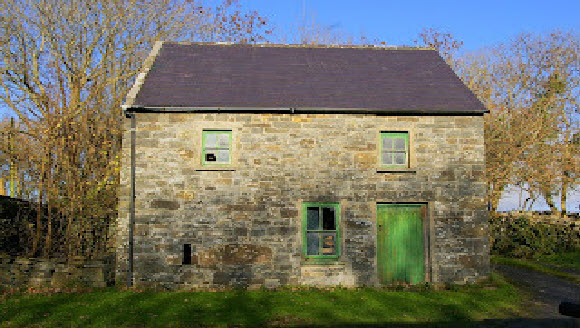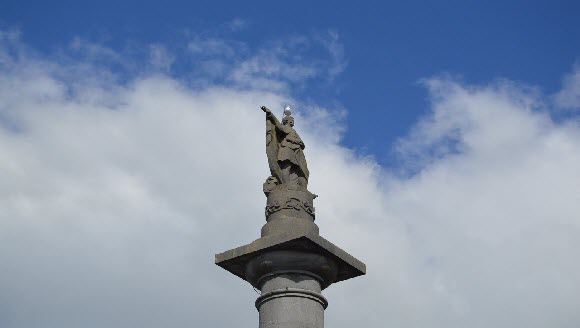Protected structures
Architecture is a dynamic entity, which may need to adjust to meet the needs of the current and future generations. Buildings have a practical role in shaping a positive future for County Clare and should be viewed as one of the many assets that make the county an attractive place in which to live, work and visit.
What is a protected structure?
A protected structure is a building or other feature, (such as a bridge, memorial or castle), which, in the opinion of Clare County Council, is of such special Architectural, artistic, archaeological, cultural, social, scientific or technical interest that it should be afforded legal protection so that its intrinsic value can be appreciated by future generations. Such structures can range from the humblest thatched cottage to the largest ‘country house’.
Under the Planning and Development Act 2000 (as amended), a Protected Structure legally incorporates the following:
- the interior of the structure
- the land lying within the curtilage of the structure
- any other structures lying within the curtilage and their interiors, and
- all fixtures and features, which form part of the interior or exterior of any structure(s), referred to in subparagraph (a) or (c).
Provision is also made for protection to be extended to include features such as gate lodges, gazebos, and so forth which have passed into new ownership through the break-up of an estate or the division of a property.

The resources below provide information about the Record of Protected Structures (RPS) and Architectural Conservation Areas (ACA) in County Clare, as well as studies into Clare’s rich architecture, follow the links below:
- Volume 1 of the Clare County Development Plan 2023-2029: Written Statement - Appendix 4 Architectural Conservation Areas in County Clare [PDF, 28.9MB]
- Volume 4 of the Clare County Development Plan 2023-2029: Record of Protected Structures [PDF, 16.5MB]
- The Bridges of North County Clare - An Inventory of Civil Engineering Heritage [PDF, 11.7MB]
- Clare Coastal Architectural Survey 2008 [PDF, 15.2MB]
- Industrial Heritage Review of County Clare [PDF, 10.5MB]
- Architectural Surveys of County Clare
The National Inventory of Architectural Heritage was established to identify, record and evaluate the architectural heritage of the country in a systematic and uniform manner. Each county inventory is published in a full-colour, attractively illustrated booklet introducing the architectural highlights of the area, with descriptive text and photographs, and relevant mapping.

The Daniel O’Connell Monument in Ennis was erected in 1867, on the site of the former courthouse, demolished in 1852.
Responsibilities
Under current legislation an absolute Duty of Care is placed upon the owners and occupiers of Protected Structures to ensure that they are not endangered by either undertaking inappropriate works, direct demolition or through neglecting the building. This Duty of Care also applies to building contractors and all others who are involved in caring for Protected Structures.
Advice
Clare County Council shares in this responsibility, and the Architectural Conservation Officer within the Planning Department, is in a position to offer advice, guidance, help and information to the stakeholders in the county’s built heritage, be they owners, occupiers, auctioneers, solicitors or members of the general public.
Record of protected structures
The Record of Protected Structures lists all protected structures and buildings in Clare. The Record of Protected Structures, which contains summary details on each building or feature, is contained within the County Development Plan or through clarification by the Planning Departments Conservation Officer. The owner of a protected structure can seek a Section 57 declaration outlining works which would and would not require planning permission. The ACO conducts a site inspection of the protected structure and issues the Section 57 to the owner. The ACO also submits funding and grant applications to the Department of Housing, Local Government and Heritage. Clare County Council administers the funding on behalf of the Department. The ACO is available to visit sites for inspection and answer queries relating to the conservation of protected structures, as well as to guide owners in their applications There are 918 Protected Structures in the Record of Protected Structures [PDF,16.5MB] and over 30 designated Architectural Conservation Areas (ACAs) in Clare.
Restrictions
Due to a number of factors, not least the fact that many modern buildings materials and techniques are harmful to the fabric of old buildings, safeguards on the work that can be undertaken on Protected Structures have been introduced. These safeguards include an absolute ban on all work classified as ‘exempted development’ including normal maintenance such as painting and installing wall or floor tiles. There are very good and valid reasons, based on practical experience gained in the care and maintenance of old buildings, for these measures of protection.
In order to undertake works on a Protected Structure, an owner or occupier must be in possession of either:
- Planning Permission
- A Section 57 Declaration – This is a document available from the Planning Department of Clare County Council which states the nature and scope of works that may be undertaken which will not affect the character of the building
- Declaration in Part covering works aided by the Conservation Grant Scheme
Offences and penalties
- “Any person who without lawful authority causes damage to a protected structure or a proposed protected structure shall be guilty of offence” (Section 58(4) Planning and Development Act 2000 (as amended)
- “A person who is guilty of an offence…shall be liable (a) on conviction on indictment, to a fine not exceeding €13,000,000 or imprisonment for a term not exceeding 2 years” (Section 156(1) Planning and Development Act 2000 (as amended)
Conservation grant schemes
Protected Structures legislation provides for grant assistance to aid owners and occupiers in caring for their buildings. The works must be undertaken with an emphasis on conserving as much as possible of the original material in the building and structures. If necessary, replication is permitted and, as funding permits on a year-to-year basis, restoration works (such as replacing uPVC windows with appropriate timber sash windows) are also assisted.
The type of projects which Clare County Council is assisting include:
- Structural Stability Works
- Weatherproofing
- Damp Proofing
Application forms, advisory documents and booklets are available from the Conservation Officer of the Planning Department or on the Conservation grant schemes.
Planning permission procedures for protected structures
Any works to a Protected structures normally considered as ‘exempted development’ require planning permission. Such works include extensions to the rear, the erection of satellite dishes, even television aerials and so forth. Secondly, the newspaper advertisements and site notice must state that the structure is protected. Thirdly, all applications for the development of a Protected Structure (including the grounds in which the building is located) must be accompanied by sufficient plans, drawings and particulars to show how the proposed development would affect the character of the structure. It is not possible to apply for outline planning permission for development work on a protected structure.
In the case of minor works to a protected structure i.e., repairs works, these can be carried out without planning permission only if the works would not affect the character of the structure or any element of the structure that contributes to its special interest. Section 57 of the Planning and Development Acts 2000 (as amended) allows for the owner or occupier of a Protected Structure or a Proposed Protected Structure to submit a written request to the planning authority to issue a Section 57 Declaration as to the type of works which it considers would or would not materially affect the character of the structure or any element of the structure, thereby clarifying which works would be considered exempted development. A request for a Section 57 Declaration can be made by completing the following application form.
Definitions
An Architectural conservation area is a place, area, group of structures or townscape that is of special architectural, scientific, social or technical interest, or that contributes to the appreciation of a protected structure, whose character it is the objective of a development plan to preserve - Section 52 (1) (b) of the 2000 Act.
Area of special planning control areas of special planning control provide powers to planning authorities not alone to give protection to the character of certain qualifying areas, but also to enhance that character, that is, to restore it and to require owners and occupiers to conform to a planning scheme – Section 84, of the 2000 Act
Section 57 Declaration Owners or occupiers of a protected structure may request a declaration‘ under Section 57 of the 2000 Act. The purpose of which is for planning authorities to clarify in writing the kind of works that would or would not materially affect the character of that structure or any element of that structure which contributes to its special interest. Declarations guide the owner as to what works would and would not require planning permission in the context of the protection of the architectural heritage. This is because the character of a protected structure cannot be altered without first securing planning permission to do so.
RMP Archaeological sites are legally protected by the provisions of the National Monuments Acts, the National Cultural Institutions Act 1997 and the Planning Acts. The National Record of Monument & Places (RMP) is a statutory list of all known archaeological monuments provided for in the National Monuments Acts. It includes known monuments and sites of archaeological importance dating to before 1700AD, and some sites which date from after 1700AD.
RPS & Record of Protected Structures. A Protected Structure is a structure which is considered to be of special interest from an architectural, historical, archaeological, artistic, cultural, scientific, social or technical point of view. The Record of Protected Structures (RPS) is a list of the buildings held by am authority which contains buildings considered to be of special interest in its operational area. Section 51 (of the 2000 Act) requires that the development plan shall include a Record of Protected Structures and that the Record shall include every structure which is, in the opinion of the Planning Authority, of special interest.
For reference, see NIAH Handbook Edition May 2024. Architectural Heritage Protection Guidelines for Planning Authorities [PDF,4.12MB] published by the Department in 2011.
Page last reviewed: 19/11/24
Content managed by: Planning Department
Back to topContact
Áras Contae an Chláir
New Road
Ennis
Co. Clare
V95 DXP2
(065) 684 6407
Phone lines
• Open Monday – Friday 9:00 a.m. to 5:00 p.m.
• Closed - Saturdays, Sundays and Bank Holidays Public counters
• Cash Office: Open Monday – Friday 9:00 a.m. to 4:00 p.m
• Customer Services: Open Monday – Friday 9:00 a.m. to 5:00 p.m
• Planning: Open Monday – Friday 9:00 a.m. to 4:00 p.m
This is just for feedback on our web site, not comments or questions about our services.
To tell us about anything else, go to our contact us pages.
